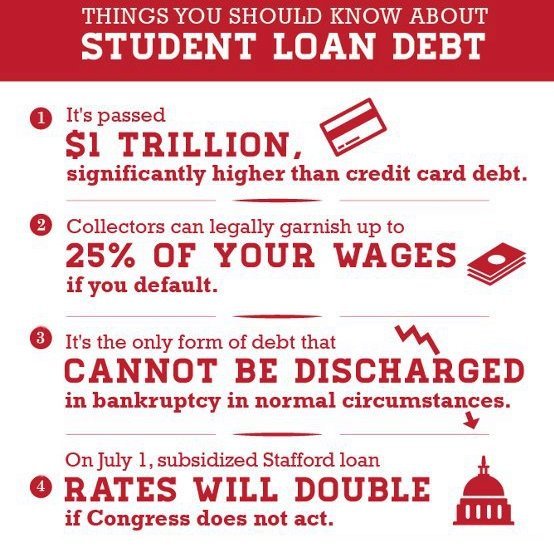Table of Content
When determining the average monthly student-loan payments of their borrowers, lenders traditionally used a figure equal to 1 percent of borrowers' outstanding student loan debt. That 1 percent figure could be more than the actual amount that borrowers were paying on their student loans each month. When mortgage companies decide who gets approved for a home loan, they typically consider your debt obligations, credit rating and employment history. Student loan payments can have a negative impact on your debt-to-income ratio, or DTI, and how underwriters view your debt obligations. In short, if underwriters feel you won’t be able to afford the monthly mortgage payment due to your student loans, they probably won’t approve you.

It can be calculated by taking all your incoming money (salary, investments, etc.) and comparing that figure to your total existing debts. The higher your DTI ratio, the riskier a lender will consider your loan. Here we'll take a closer look at VA loan guidelines with student loans and how this type of debt impacts your VA loan eligibility. Before exploring your homebuying options, it’s helpful to understand the different factors a mortgage lender will use to determine whether to approve you for a loan and how much you can afford. We break these down below, along with tips for how to increase your chances of qualifying.
How Refinancing Can Hurt Insurance Rates
Learn more with Ratehub's guide to managing your money as a student. I don't have debit card access to this account, which is a tip I recommend if you want to avoid the temptation of dipping into any of this money. “A default is really, really bad … and the later is, the more damage to your credit score,” says Bev O’Shea, a credit expert and former NerdWallet writer. The percentage increases may seem small, but they represent hundreds of thousands of borrowers. If you would like, you can shoot me an email at and let me know what State you’re in.

These aspects will positively impact your mortgage approval and ensure your student loans don’t overly hinder your mortgage approval process. However, because your payment history is generally important to lenders, making student loan payments on time can actually help your credit scores. When you take out a loan for your education, you’re making a commitment to pay back the money you borrowed—and that means paying higher interest rates than those who don’t have debt. This can make it harder to get approved for a home loan because lenders will be more wary of lending you money if they know you have other debts.
Step 3: Get preapproved for a mortgage before you house hunt
In one of the more important of these rules, lenders originating mortgages guaranteed by Fannie Mae no longer must count the non-mortgage debt that other people are paying on behalf of borrowers. If your parents, then, have agreed to pay your student-loan debt, credit-card debt or auto loan, mortgage lenders will no longer count this debt as part of your debt-to-income ratio. Another way to make room for a mortgage is to refinance and extend the life of your college loan. This results in smaller payments over a longer period of time—and more money you can put toward a mortgage. Of course, one downside is you’ll end up paying more in interest over the life of your college loan; however, it means you can buy a home now, which may well be worth it. To learn more, Student Loan Hero picked six of the best private lenders for student loan refinancing.

You may not qualify for a conventional loan if you have a DTI ratio that’s higher than 50%. A conventional loan is a mortgage that follows guidelines set by Fannie Mae and Freddie Mac, which standardize mortgage lending in the U.S. However, you may still be able to buy a home with a government-backed loan. These loans are insured by the federal government, making them less risky for a loss from a default. This allows mortgage lenders to issue loans to borrowers with higher DTI ratios.
Do You Have Questions About Qualifying?
In this situation, you should pay more than your minimum and focus on paying off your loans first before you take on more debt with a mortgage. You don’t need to pay off your student loans to qualify for a mortgage. Still, keeping up with your student loan payments is crucial; if you miss a monthly payment, your credit score could take a big hit, which in turn could hurt your eligibility for a home loan. If you have student loans, you can defer payment on the debt while you're in school, which means you're able to reduce your overall debt load as a student.

However, they have also repeatedly extended the pause despite earlier statements that they would not be doing so again. Congressional Republicans have vehemently opposed the latest extension, with Education and Labor Committee Republican Leader Virginia Foxx (R-NC) calling it “fiscal insanity” in a statement last month. With uncertainty and repayment looming in the months ahead, borrowers struggling with other bills can still get ahead. Student debt cancellation of up to $20,000 per borrower — now on ice as the program’s legality is challenged by multiple lawsuits — could be a big help, the CFPB found. A mortgage term is the length of time you have to repay your mortgage loan. Although there is no set time frame, the custom within the real estate industry is that mortgage pre-approval is valid for between 90 to 180 days.
We’ve maintained this reputation for over four decades by demystifying the financial decision-making process and giving people confidence in which actions to take next. Suzanne De Vita is the mortgage editor for Bankrate, focusing on mortgage and real estate topics for homebuyers, homeowners, investors and renters. “Expert verified” means that our Financial Review Board thoroughly evaluated the article for accuracy and clarity. The Review Board comprises a panel of financial experts whose objective is to ensure that our content is always objective and balanced. How To Assess Your Finances And Calculate What To Spend Home Buying - 10-minute read Miranda Crace - October 25, 2022 Home buyers often wonder how much house they can afford.

If you're still a student and want to be a homeowner, read on to learn more about what you need to know about being a college-going mortgagor and tips you may be able to use to balance the two. A home is probably the largest purchase you'll ever make in your lifetime. After all, it costs a lot of money for anyone—even those who work full-time.
However, VA loans don’t call for including student loan payments in your DTI ratio if those payments are to be deferred at least 12 months after the date your VA loan closes. What happens if your student loans are in forbearance or deferred? Based on Fannie Mae guidelines, your lender can factor either 1 percent of your remaining student loan balance into your DTI, or one payment based on what’s indicated in your student loan repayment terms. At least six months before you apply for a mortgage, and make all payments on time to get the greatest boost.
The loan amount is the amount of money you plan to borrow from a lender. Lenders will compare your income and debt in a figure known as your debt-to-income ratio. Your debt-to-income ratio is the percentage of gross income that goes toward your debt. Once you have a loan, you pay it back in small increments every month over the span of years or even decades.
Federal Housing Administration loans allow first-time homebuyers to get loans with as little as 3.5% down. If you are a military veteran, you may be eligible for a home loan made available through, and partially guaranteed by, the U.S. Consider asking for a raise at work or picking up a side hustle to increase your monthly gross income. The realtor.com® editorial team highlights a curated selection of product recommendations for your consideration; clicking a link to the retailer that sells the product may earn us a commission.
Student loans in a “forgiveness” plan/program remain your legal responsibility until you are released of liability from the creditor. We’ll set the record straight today by discussing student loan guidelines when trying to qualify for a USDA mortgage. It is not uncommon for inexperienced loan officers to use the guidelines of one loan program and incorrectly apply them to your USDA loan application. You may also be eligible for an additional $10,000 in relief if you received federal Pell Grants while enrolled in college, totaling up to $20,000 in debt relief. Student loan debt forgiveness continues to face challenges with a block on the program.
Lenders will calculate your student loan payments into your debt-to-income ratio in one of two ways. If you are on an income-based repayment plan and your monthly payment amount is greater than $0, they will factor that number into your DTI. If your IBR payment is $0 or you are in forbearance, they will use 0.5% of your outstanding loan balance to determine your DTI. On the other hand, if you’re paying your student loans in a timely manner, this can help create a positive credit profile. You may want to consider using one of the income-driven repayment plans offered by the Federal Student Aid office, which reduces your monthly loan payments. Most federal student loans are eligible for one of these plans.

These total debts include student loan debt, credit card debt, car loans, personal loans — whatever you must pay to creditors every month — plus mortgage payments. Generally, lenders look for a DTI ratio of 41 percent with a USDA loan, but it can exceed that in some circumstances. If you’re making fixed monthly payments on your student loans, your mortgage lender will consider what’s on your credit report or student loan statement for your DTI ratio. But when you use an IDR plan, know that mortgage lenders have specific formulas to determine how your student loan payment fits into your DTI ratio. For example, lenders who make FHA loans use 1% of the outstanding student loan balance you’re repaying on an IDR plan as your monthly payment obligation.











